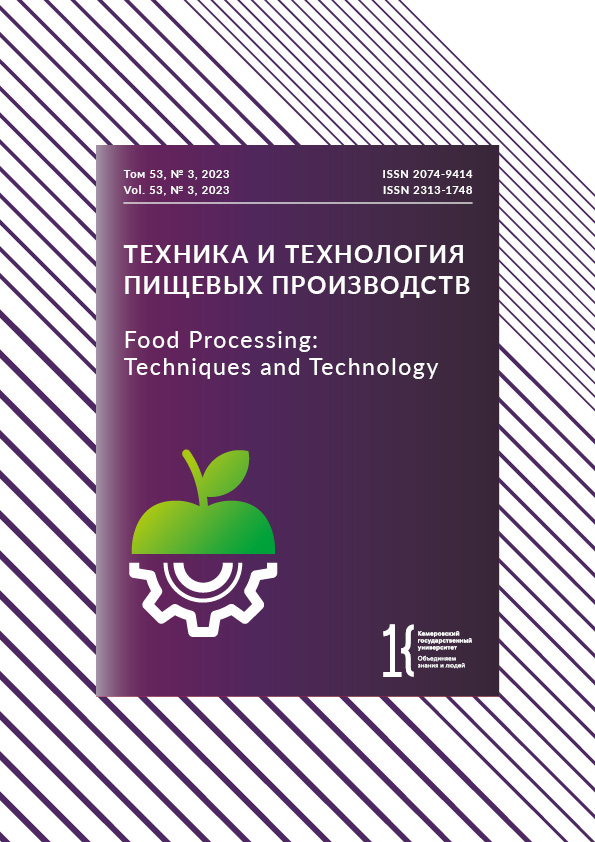Barnaul, Barkaul, Russian Federation
UDC 66
UDC 60
Yachmen' proizrastaet prakticheski povsemestno na zemnom share, v Rossii ob'emy proizvodstva yachmenya - samye bol'shie v mire, a tradicii ego upotrebleniya v pischu uhodyat v glubokuyu drevnost', belki yachmenya sposobny obrazovyvat' kleykovinu, chto dalo osnovanie vydvinut' gipotezu o vysokih funkcional'no-tehnologicheskih svoystvah yachmenya i perspektivnosti primeneniya ego v kombinirovannyh molochno-zlakovyh produktah. Pokazana vozmozhnost' ispol'zovaniya v recepture molochno-zlakovyh produktov yachmenya s minimal'noy podgotovkoy i maksimal'nym sohraneniem vseh chastey ishodnogo zerna. Tehnologiya termomehanicheskoy obrabotki yachmenya baziruetsya na tradicionnoy tehnologii talgana: zerna yachmenya ochischayut ot postoronnih primesey i obolochek, ochischennyy yachmen' obzharivayut pri temperature 130-150 °S v techenie 5-10 min, obzharennyy yachmen' ohlazhdayut do komnatnoy temperatury i izmel'chayut do razmera chastic 0,25-0,9 mm. Izuchen himicheskiy, v tom chisle aminokislotnyy, mineral'nyy i vitaminnyy, sostav yachmenya posle takoy obrabotki, pokazana ego vysokaya pischevaya i biologicheskaya cennost'. Dokazano, chto podgotovlennyy po takoy tehnologii yachmen' obladaet vysokimi funkcional'no-tehnologicheskimi svoystvami (vodouderzhivayuschaya, zhirouderzhivayuschaya, zhiroemul'giruyuschaya sposobnosti). Izucheny zakonomernosti proyavleniya funkcional'no-tehnologicheskih svoystv obrabotannogo yachmenya v molochno-zlakovom produkte i dokazano, chto yachmen' sohranyaet eti svoystva pri vnesenii v molochno-belkovuyu osnovu. Predlozheno ispol'zovat' podgotovlennyy yachmen' v recepture molochno-zlakovyh produktov s otnositel'no vysokim soderzhaniem vlagi i zhira, takih kak pasty, plavlenye syry, tvorozhnye produkty, molochno-belkovye deserty. Polozhenie proillyustrirovano konkretnoy tehnologiey kombinirovannogo molochno-zlakovogo produkta s obrabotannym yachmenem, gde v kachestve osnovy ispol'zovan koprecipitat.
Dairy-cereal products, barley, thermomechanical processing of barley, functional and technological properties
1. Shulbaeva, M.T. Razrabotka tehnologii molochno-belkovyh past s uchetom nacional'nyh tradiciy Respubliki Hakasiya: dis.. kand. tehn. nauk: 05.18.04 / Shulbaeva M.T. - Kemerovo, 2002. - 136 s.
2. Musina, O.N. Kombinirovannye produkty v otechestvennom syrodelii / O. N. Musina. - Barnaul: Izd-vo Altayskogo gos. un-ta, 2007. - 170 s.
3. Musina, O.N. Tvorozhnye produkty s zernovymi ili zernobobovymi komponentami / O.N. Musina // Molochnaya promyshlennost'. - 2007. - № 10. - S. 33.
4. Rastitel'nye belkovye preparaty: kompozity, sostav, svoystva, naznachenie / V.V. Kolpakova, A.A. Nevskiy, A.A. Vasil'ev, Z.V. Vasilenko // Hranenie i pererabotka sel'hozsyr'ya. - 2010. - № 6. - S. 39-41.
5. Konovalov, K.L. Pischevye veschestva zhivotnogo i rastitel'nogo proishozhdeniya dlya zdorovogo pitaniya / K.L. Konovalov, M.T. Shulbaeva, O.N. Musina // Pischevaya promyshlennost'. - 2008. - № 8. - S. 10-12.
6. Konovalov, K.L. Pischevye rastitel'nye kompozity funkcional'nogo naznacheniya / K.L. Konovalov, M.T. Shulbaeva, A.I. Lutovinova // Pitanie i obschestvo. - 2009. - № 7.- S.13-14.
7. Musina, O.N. Polikomponentnye produkty na osnove kombinirovaniya molochnogo i zernovogo syr'ya / O.N. Musina, M.P. Schetinin. - Barnaul: Izd-vo AltGTU, 2010. - 258 s.
8. A dietary pattern characterized by high consumption of whole-grain cereals and low-fat dairy products and low consumption of refined cereals is positively associated with plasma adiponectin levels in healthy women / M. Yannakoulia, N. Yiannakouris, L. Melistas et al. // Metabolism. - 2008. - Vol. 57, № 6. - P. 824-830.
9. Consumers’ associations with wellbeing in a food-related context: A cross-cultural study / G. Aresa, L. Saldamandoa, A. Giméneza et al. // Food Quality and Preference. -2014. -№. 6.
10. Application of cereals and cereal components in functional foods: a review / D. Charalampopoulos, R. Wang, S.S. Pandiella, C.Webb //International Journal of Food Microbiology. - 2002. -Vol. 79, № 1-2. - R. 131-141.
11. Al'van, A. Funkcional'nye svoystva belkovyh produktov iz semyan kunzhuta / A.Al'van, A.D. Minakova, V.G. Scherbakov // Izvestiya vuzov. Pischevaya tehnologiya. - 1999. - № 2-3. -S. 17-18.











